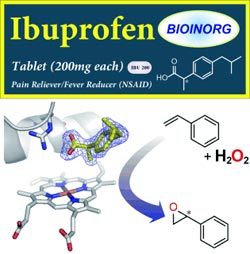Ibuprofen Decoy

<br>
Enzymes can be efficient biocatalysts for organic synthesis, but often only work on a small range of specific substrates.
Yoshihito Watanabe and colleagues at Nagoya University and RIKEN (Japan) have tricked enzymes into catalyzing reactions between molecules of choice, they report in Chemistry—An Asian Journal. By using organic acids, including the pain reliever ibuprofen, they mimicked the natural substrate.
The researchers used one member of the family of so-called cytochrome P450 enzymes, which owe their catalytic activity to the same heme group that binds oxygen in hemoglobin in the blood. They were able to expand its substrate scope by using organic acids to simulate substrate binding. The carboxylic acid group activates the H2O2 oxidant, which finally results in oxidation of the heme iron atom and generation of the active species.
This “decoy” approach allows epoxidation of styrene, which cannot normally be achieved with P450 enzymes. When an asymmetric decoy is used, such as the common pain reliever ibuprofen, the epoxidation proceeds stereoselectively: Only the desired molecule is produced, but not its mirror image, which can make the difference between a drug and a poison.
Further optimization of the system both in terms of decoy molecule and P450 mutant should yield higher catalytic activity and better stereoselectivity. This method should prove valuable in expanding the use of enzymes in organic synthesis.
About the Author
Dr. Yoshihito Watanabe is Vice President of Nagoya University and Professor at the Research Center for Materials Science there. His research concentrates on metalloenyzmes for catalysis.
Author: Yoshihito Watanabe, Nagoya University (Japan), http://bioinorg.chem.nagoya-u.ac.jp/
Title: Chiral-Substrate-Assisted Stereoselective Epoxidation Catalyzed by H2O2-Dependent Cytochrome P450SPá
Chemistry – An Asian Journal, Permalink to the article: http://dx.doi.org/10.1002/asia.201200250
Media Contact
All latest news from the category: Life Sciences and Chemistry
Articles and reports from the Life Sciences and chemistry area deal with applied and basic research into modern biology, chemistry and human medicine.
Valuable information can be found on a range of life sciences fields including bacteriology, biochemistry, bionics, bioinformatics, biophysics, biotechnology, genetics, geobotany, human biology, marine biology, microbiology, molecular biology, cellular biology, zoology, bioinorganic chemistry, microchemistry and environmental chemistry.
Newest articles

Superradiant atoms could push the boundaries of how precisely time can be measured
Superradiant atoms can help us measure time more precisely than ever. In a new study, researchers from the University of Copenhagen present a new method for measuring the time interval,…

Ion thermoelectric conversion devices for near room temperature
The electrode sheet of the thermoelectric device consists of ionic hydrogel, which is sandwiched between the electrodes to form, and the Prussian blue on the electrode undergoes a redox reaction…

Zap Energy achieves 37-million-degree temperatures in a compact device
New publication reports record electron temperatures for a small-scale, sheared-flow-stabilized Z-pinch fusion device. In the nine decades since humans first produced fusion reactions, only a few fusion technologies have demonstrated…





















